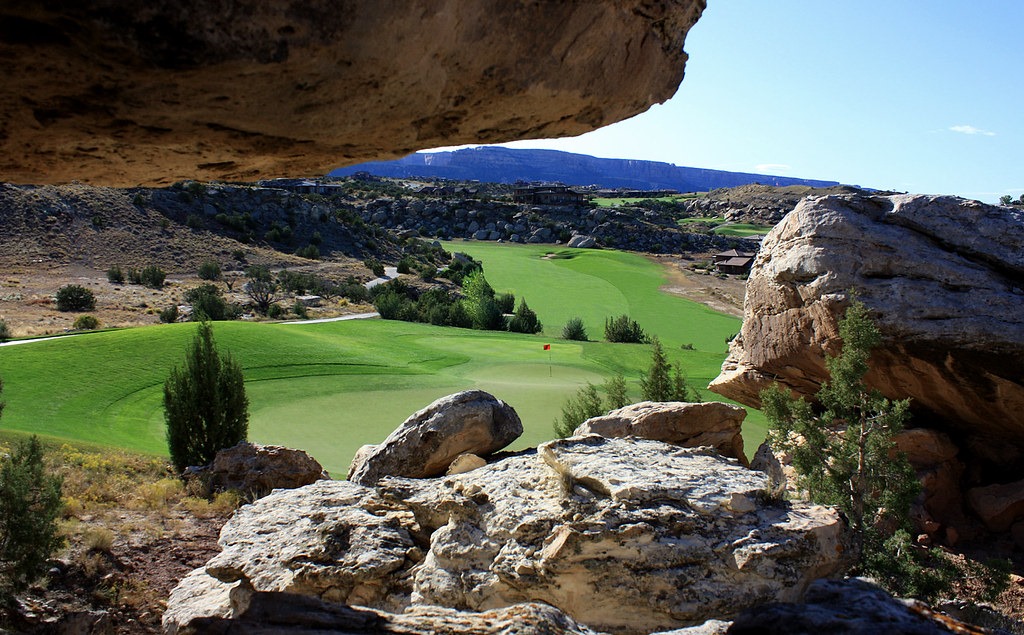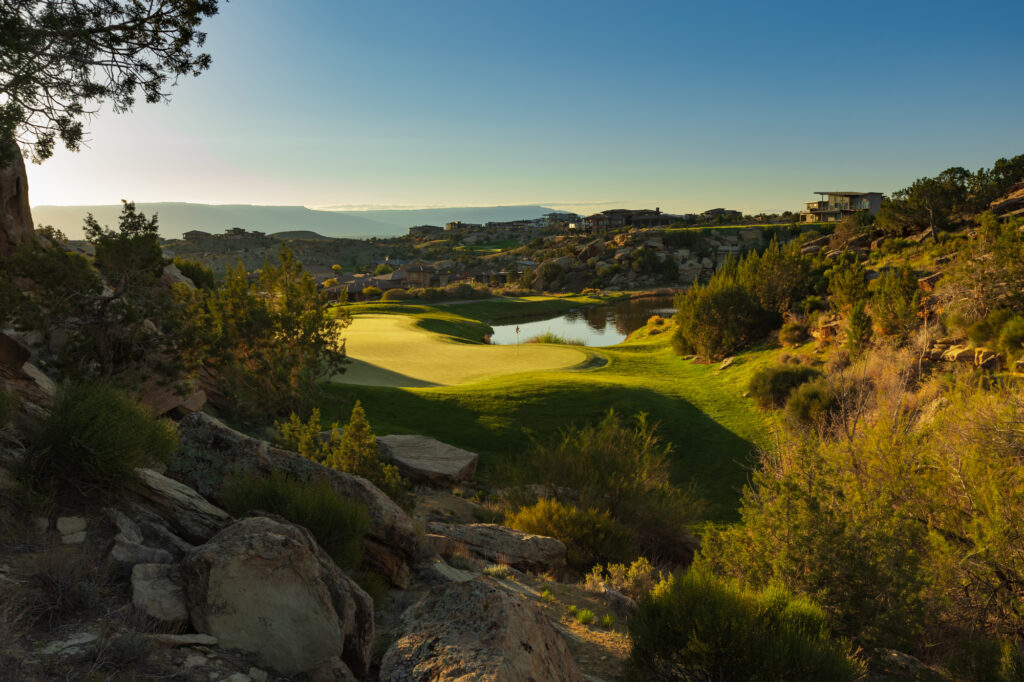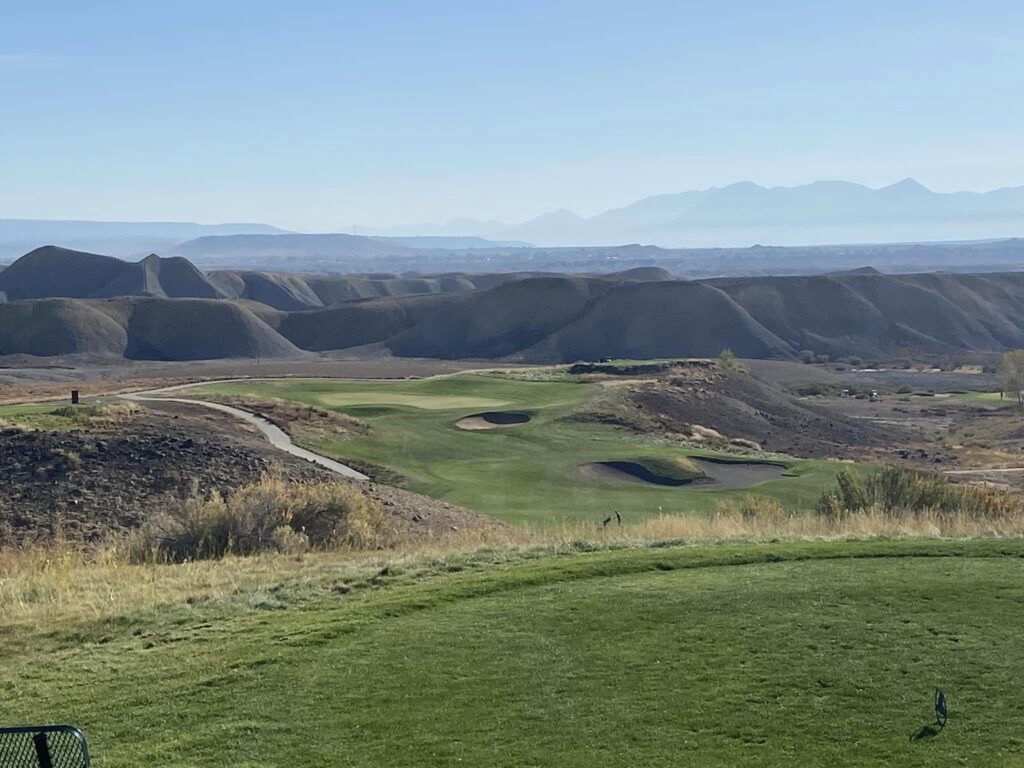
Redlands Mesa
When one initially thinks about playing golf in Colorado, it’s likely about either up-and-down Alpine courses in the towns and resorts of the Rocky Mountains or more parkland-style tracks on the near-eastern side of the state in the plateaus that are the run-up to the craggy peaks.
Here’s another great option: go play on Colorado’s Western Slope, the region incorporating everything in the state west of the Continental Divide.
Despite plenty of towering mountains and deep canyons, temperate weather where golf can be played 10 out of 12 months, and a laidback but hip vibe, the destinations and golf courses of the Western Slope don’t often get the accolades that other areas of the Centennial State seem to claim as a birthright – and that’s a mistake.
Travel Caddie has visited the area extensively, played many of the top courses on the Western Slope and profiles below three of those tracks – The Golf Club at Redlands Mesa in Grand Junction, Devil’s Thumb Golf Course in Delta, and The Bridges Golf & Country Club in Montrose.
Count us in as considering this region and its varied golf facilities to be “hidden gems” and “must plays” for trip to this area that’s also known for its ranching, mining, fruit-growing and tourism.
Engh employs broad brushstrokes at Redlands Mesa
Set at 4,600 feet above sea level, Grand Junction is the gateway to the cliffs of the Colorado National Monument, the Grand Mesa (the world’s largest flat-topped mountain) and the Book Cliff Mountains, all of which create a dramatic backdrop for this city of 70,000.
It was with this set of natural attributes that golf architect Jim Engh fashioned the fascinating Golf Club at Redlands Mesa. Eleven of the holes play downhill off elevated tees, making this one of the most scenic golf courses in the western United States, with high-desert panoramas of pink, red and tawny tints.
The par-72 7,007-yard venue opened in 2001 and features one pretty hole after another.
Redlands Mesa can be a bit intimidating for players who are shy of forced carries; it’s also bad news when straying into the rocky areas bordering a hole. In fact, the landing areas are pretty generous as most fairways are wide if not well-defined off the tee. Adding spice are 40 bunkers.
Engh’s multi-tiered greens are demanding, so hitting the correct level is essential to scoring well. Redlands Mesa has only one par 4 longer than 429 yards (the 466-yard seventh) and is defined by risk-reward two-shotters, three of which are 389 yards or less.
The 370-yard 14th may be the most controversial hole. After about 280 yards, the hole turns 90 degrees right toward a long and skinny green. Any tee shot hit less than 280 yards faces a tough approach. Depending on the line, the second shot must be made over boulders atop the hill at the corner of the dogleg. The hole resembles a huge question mark with towering rocks in the bend.
Redlands Mesa’s toughest test is likely the 412-yard par-4 16th. After a drive to a broad landing area, the fairway heads sharply left and uphill to a 44-yard-deep, partially hidden green. Short and left are seven small pot bunkers, each of which can ruin any chance at par.
Then you get the course’s signature hole, the 218-yard 17th, which drops 150 feet off its hillside-cut perch to a green in a rock-framed bowl.
The challenge at the Golf Club at Redlands Mesa is to keep your focus as there’s stunning scenery at many junctures. It’s likely enjoyed more on the second time around after the wow-factor has been tempered and there’s more understanding of a way to play the sometimes tricky, but not tricked-up, routing.

Redlands Mesa
Devil’s Thumb may be Colorado’s truest desert-style course
Located in the foothills north of Delta, the Rick Phelps-designed Devil’s Thumb opened in 1992 and offers a unique blend of physical attributes. Phelps calls the course “prairie-style,” but its stark setting among the Adobe Hills at the southern base of the Grand Mesa and its tendency for exacting shots amid harsh and unkempt surroundings make it more like a layout found in the desert Southwest.
The strength of Devil’s Thumb Golf Course is the site itself.
“This is such an odd place for Colorado, but it is beautiful,” Phelps said. “Looking from the course to the northeast reminds me of the surface of moon, but it’s the combination of the terrain and location that made the site interesting to me.”
The course is named for a striking rock formation that looms above it (like a thumb extended out of the earth) to the northwest. The Ragged and West Elk Mountains dominate the near-eastern horizon, while the San Juan Mountains, Black Canyon and Uncompahgre Plateau enhance the picture to the south, making Devil’s Thumb one of the starkest and most scenic courses anywhere.
The par-72 Devil’s Thumb stretches 7,176 yards from its back set of five tees, with that distance mitigated by the property’s setting at about 5,100 feet above sea level.
In excess of 60 bunkers and a trio of small lakes complicate the course’s equation, while some holes offer split fairways and chances to drive the ball over rocky mounds to reduce distances to the greens. Full-time consideration is the wind, which at this exposed spot blows from any and all directions.
The fairways play hard and fast and were built on the Adobe Badlands with a clay and Morrison stone base that dates back to when dinosaurs sloshed long-ago-evaporated tide pools.
The 435-yard par-4 sixth might be the toughest hole on the course, moving off the tee across a wasteland to an elevated, rolling fairway protected at the landing area by a large bunker. The putting surface, further up the rise, is shallow and wavy.
The stunning, 414-yard par-4 13th creates a choice off the tee: play straight downhill and between rocky mounds or take the overland route to a small auxiliary fairway near the landing area of the third hole. Either tack will leave a tough shot to a narrow, two-tiered green.
Devil’s Thumb’s closer is a round-the-lake, 557-yard par-5. For those tempted to try for the putting surface in two, both water and sand along the right side are serious considerations; a more prudent line is left of the trouble for a short wedge to the hill-perched green.
Devil’s Thumb is a hidden gem, a “diamond in the no-so-rough.” But, after opening, it was recognized as the No. 2 best new affordable public golf course in America by Golf Digest.

Devil’s Thumb
The Bridges showcases Nicklaus’ design philosophies
The bustling burg of Montrose is set at about 5,800 feet of elevation on a plain surrounded by natural wonders and sports views of the San Juan and Cimarron Mountains. For a golf course to compete for attention, it needs some flair and The Bridges Golf & Country Club here fits that bill.
The Bridges (originally the Bridges at Black Canyon) was fashioned by Jack Nicklaus. And while the course at The Bridges Golf & Country Club gets its name from the many distinctive cart and walking bridges used to navigate the track, the real highlight here is the way Nicklaus sculpted the land (which was originally flattish) into a rolling, lake-filled test.
More than 850,000 cubic yards of earth were moved to shape the gently rolling course, and 85 bunkers are scattered about. Water enters play on 16 of the 18 holes. Some fairways wind around rugged natural arroyos. The Bridges incorporates native plantings, rock features and waterfalls, playing at 7,207 yards from its back set of four tees.
Since most of the fairways are generous, the Bridges gets its bite from large greens with multiple levels, making accuracy on approaches a must. Unique features include a shared tee on Nos. 2 and 11, and the 15th is a par-5 with two separate greens – one at 572 yards and the other at 600 yards and on the far side of a canal.
The front nine is highlighted by a four-hole stretch that includes the course’s three longest par-4s and its shortest par-3.
There are plenty of tests and variety on the trip before the player reaches the 444-yard closer, which heads toward the clubhouse on the horizon and features a lake along the left that encroaches on the drive and approach. Two gnarly bunkers guard the elevated putting surface, making the final full shot of the round quite difficult.
It’s easy to see the design trends Nicklaus and his team have adopted over the past two decades (wider driving corridors, more mounding and added severity to greens) in their work at The Bridges. The track is fun and demanding and keeps your attention throughout.

The Bridges

